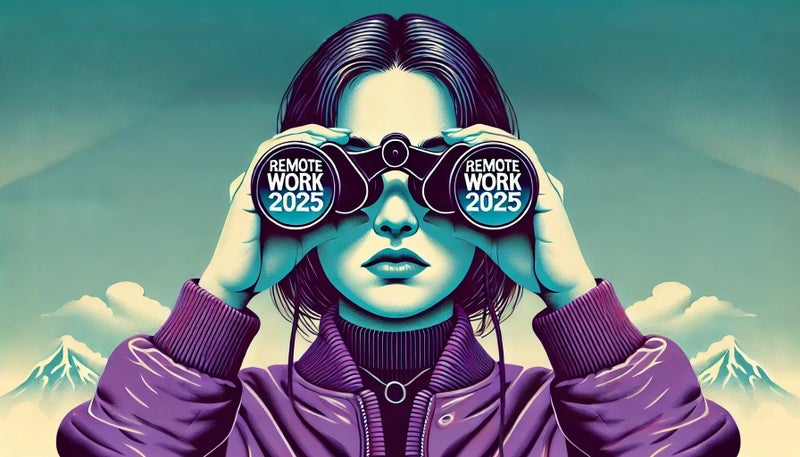Contents
- Trend 1: AI and Automation Enhance Remote Work
- Trend 2: The Rise of the Borderless Workforce
- Trend 3: Mental Health Moves to Center Stage
- Remote Work Trends 2025: Time to Focus
Is your understanding of 2025 remote work clouded by 2020's in-office myths? While traditional offices stumble through AI and the workplace mental health crisis, elite remote teams are redefining what work can be. Let's see how 2025's remote work is leaving the old guard behind.
Your morning starts with the latest flood of 2025 workplace predictions. Yet another batch of contradictory headlines.
"Remote Work is Dead!" screams one article. "Remote Work Revolution Unstoppable!" declares another.
Every expert seems to have a different take on where remote work is headed, and separating reality from corporate PR feels beyond impossible.
Should you be worried about AI replacing you? Is that in-office CEO right about remote work fading into the background?
The noise is deafening AND distracting.
There are three core remote work trends that will shape the remote workplace of 2025.
It's time to move past the noise and understand the real 2025 future of remote work. Here's what to focus on.
Trend 1: AI and Automation Enhance Remote Work
What people say: "AI will make you redundant. Once it masters complex tasks, your role won't exist anymore, especially if you’re remote."
The reality: AI is becoming the secret weapon of elite remote employees, automating repetitive busywork, increasing productivity, and creating space for the complex, creative problem-solving that AI can't do.
The data tells an interesting story.
Back in 2023, only 62% of business leaders and 52% of employees welcomed AI adoption. Fast forward to today, and practical employee usage of AI tools has skyrocketed from 49% to 75%.
AI ISN'T replacing remote employees. It's supercharging them.
AI adoption in the workplace has enabled workers to:
- Take on more high-value tasks (41%)
- Push into new skill territories (39%)
- Go deeper into complex problem-solving and strategic work (38%)
All while increasing productivity by a reported 37%.
Remote teams aren't just adopting AI. They're weaponizing it to deliver better work, faster.
Jillian Moore, Global Advisory Lead at Avanade, shared the following during an interview with BusinessChief.
"GenAI tools will give employees more time to create, innovate, and imagine – all of which will enable organizations to lead in their sectors and act on new ideas in ways never imagined before."
The message is clear. AI means more (and different) opportunities, not fewer.
Trend 2: The Rise of the Borderless Workforce
What people say: "Great work needs presence. Remote work is fine for basic roles, but serious careers require serious in-person collaboration."
The reality: Geography is irrelevant for elite talent. Smart companies are rethinking their working models and abandoning location requirements in favor of elite talent with elite skills.
A staggering 71% of CEOs list talent shortages as their #1 external challenge in 2024.
It's simple. They CAN'T source all the top talent they need in their local markets.
Embracing a global talent pool isn't just an option anymore. It's becoming the only viable path forward.
Smart companies are rebuilding their talent strategies around remote-first, globally distributed principles. They're not just allowing remote work – they're actively hunting for the world's best talent regardless of location.
As demand for top talent keeps growing, the old move to the opportunity model is fast drying up. The new reality is all about opportunity meeting top talent where it is.
Andrew Allen, VP of Marketing here at Crossover, recently met up with Nadia Harris to talk about the legalities of remote work. This is a MUST watch when understanding the challenges ahead.
Trend 3: Mental Health Moves to Center Stage
What people say: "Remote work is isolating. People need the separation and social interaction of office spaces for their mental health and well-being."
The reality: Traditional office spaces are a major source of workplace stress. Well-structured remote work offers the freedom and flexibility to actually prioritize mental well-being.
The numbers are crystal clear on this.
Nearly half of employees (47%) and a shocking two-thirds of CEOs (66%) report that most of their stress comes from work. Not personal life.
Pushing back against the very real workplace mental health crisis isn't about pulling people deeper into work. It's about giving them the flexibility and control to live outside of it. To build healthy work-life boundaries they need.
Remote work isn't just about avoiding commutes or working in your slippers. It's about having the power to structure your work around your life, not the other way around.
Elite remote teams are doubling down on work-life balance as a core principle.
Think strategic async communication. Dedicated focus time. Real flexibility to handle both work and life.
These aren't added perks and benefits of remote work. They're just the way remote work works.
Remote Work Trends 2025: Time to Focus
Here's our advice.
Don't look at these remote work trends (2025) as another set of predictions. Think of them as a sneak peek into the new modus operandi of elite remote teams.
AI empowerment, borderless talent, and prioritized mental well-being are the three pillars holding up 2025's future of remote work. And the time for preparation is now.
But make no mistake.
In the face of the ongoing rise of remote work, the noise around its future is only going to get louder. The difference between thriving and surviving in this distributed future comes down to one crucial choice.
To focus on what actually matters.
Are you ready to step past the noise and embrace some real remote work trends (2025)? Master your AI tools, embrace globally distributed async collaboration, and build your work-life boundaries with intention. Remote work's 2025 future is waiting.









